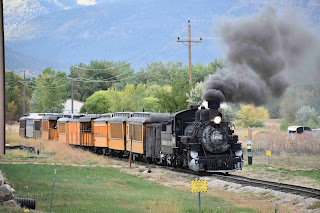We headed off from the RV Park for the drive into Santa Fe.
As we neared the old town plaza the roads got very narrow, and we luckily found
a car park with spaces for RVs. Sadly they were double the price of the standard
car parks, but given we take up at least 2 spots, probably fair enough! We
parked up and with map in hand, started walking.
First stop was the ‘oldest house in the US’. Constructed in 1646,
on the foundations of an early pueblo from around 1200AD, it was continuously
occupied until the early 1920s, by representatives of all the cultures of the
area. It is a small adobe dwelling, with thick walls, low doorways and a small fireplace
in each room.
Next door to it is San Miguel Chapel, the oldest church in
the US. Constructed in the early 1600’s it is on the site of an earlier church,
believed to have been built in 1598 over the site of an ancient kiva (spirit
house). Over the next 400 years, the Chapel was damaged and rebuilt a number of
times, and was properly restored in 1955. The Chapel was really interesting,
with lots of historical features and art, including paintings on buffalo hide
and deer skin, dating from the late 1600s. While we were there, they were
setting up audio visual equipment for a concert, so the big screen covered the
alter and the constant sound and lighting checks were distracting!


Next stop was the Loretto Chapel. The Loretto nuns undertook
a dangerous journey into New Mexico to start a girl’s school. The Chapel was
constructed as part of the school and contains an unusual spiral staircase.
Legend has it that even engineers can’t work out how it was constructed as a
double spiral without an internal post or external attachments. It is also
rumoured to have been built out of a never seen before timber, now known as
Loretto Spruce. Apparently the nuns prayed for a staircase and a carpenter
arrived, built it, and mysteriously left without asking to be paid for labour
or materials. The staircase has been the subject of many articles, TV specials,
and movies including "Unsolved Mysteries" and the television movie
titled "The Staircase." After the school was decommissioned,
the Catholic Church sold the Chapel to a local family, who maintain it as a
tourist attraction and a wedding and functions venue.

We then went to the Cathedral Basilica of St Francis of
Assisi. This building dominates the town plaza, and apparently no buildings in
Santa Fe are permitted to be built taller. One of the Government Buildings is
3 stories above and 2 stories below ground so as to not violate this rule. The
Bishop ran out of funds and was unable to top the towers with spires another 80
feet high, but if he had built them, the city would look very different. It is
a beautiful cathedral, and off to one side of the alter is the original church
dating from 1610.
We then had a wander around the plaza and surrounding streets.
The Palace of the Governor is the oldest government building in the US, and
most of the many buildings had obviously been there for most of the 400 years
of the city. Behind the street frontages, are little plazas with gardens and
courtyard dining for the many restaurants and bars.
We caught a tram tour of
the city, which was well worth it. After telling us about the history of the
plaza, we were taken to the art district and surrounding suburbs. The houses
are all adobe or early colonial style often with brightly painted doors and window
frames. The tram took us to the junction of the Santa Fe Trail and the El
Camino Real trail from Mexico.
Santa Fe was a big trading depot as it was at
this junction of the Mexican Trail and the American Trail, right up until the
railway bypassed it and made Albuquerque the main trading town. The City then
reinvented itself as a recovery spa for tuberculosis victims, an artists
retreat and finally a tourist attraction.
We headed out of Santa Fe to the nearby town of Las Vegas (New
Mexico), not Las Vegas (Nevada). We are camped up about 5 miles from town and
that will be tomorrows adventure!
http://maps.google.com/maps?f=q&hl=en&geocode=&q=35.51189,-105.25352&ll=35.51189,-105.25352&ie=UTF8&z=12&om=1

















































